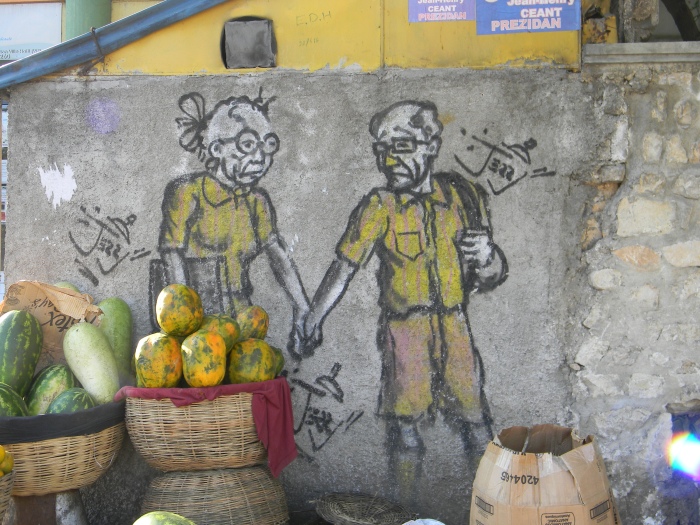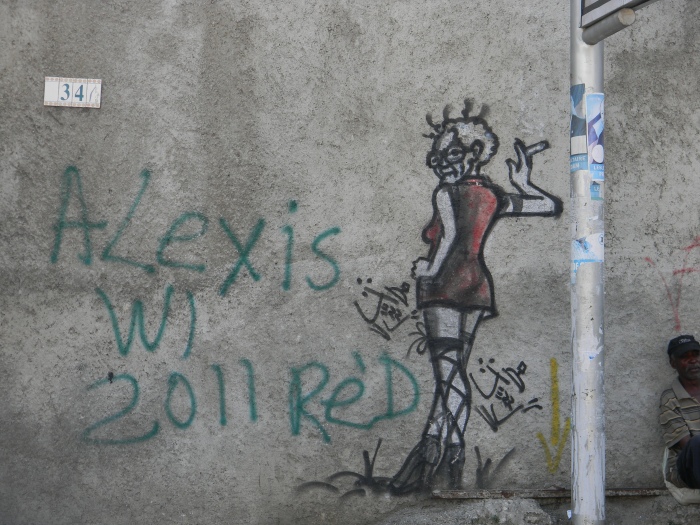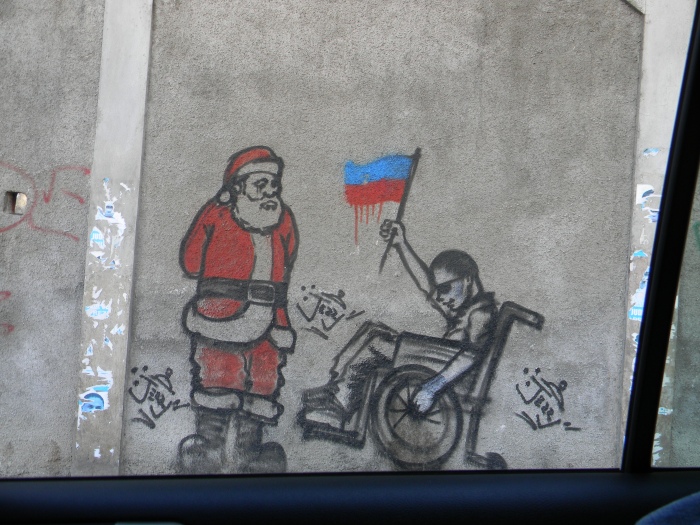There’s a long-standing tradition of political graffiti in Haiti—one that began soon after the Duvalier dictatorship ended its 29 year reign of terror with the ouster in 1986 of now newly-returned Baby Doc.
We’ve come full circle.
Duvalier is back. Aristide is on his way.
However, political graffiti isn’t gone. In fact, it’s virtually everywhere in Haiti’s capital—buildings and walls defaced by political thugs given $35 (US) and some spray paint to propagandize Port-au-Prince—scrawlings in red, black, and blue—the names of presidential candidates literally littering the city in ink.
What’s different, however, is this: there’s a new kid on the block, a graffiti artist named Jerry Rosembert Moise, who began his brilliant work just hours after an earthquake devastated his city.
What’s also different is that Jerry’s graffiti is decidedly non-political. It articulates the suffering of an otherwise silent city, whose pain is tented and tarped along rubble-strewn streets, where cholera rages and rioters react in a language of flaming tires—a solidarity of burning rubber.
Jerry, a twenty-five-year-old graphic artist by training, paints simultaneously with both hands. By now he’s completed more than 50 pieces, beginning in Port-au-Prince proper, before moving uptown to Petion-ville where we live.
Directly across the street from my partner Sara’s office, is a painting that looks like this:
Though getting good photos of this piece is now complicated by a billboad’s intrusion, you can still see the ball-holding boy, watching the world cup. There’s a lot of watching going on here, the person on the street seeing the painting, the young man staring at the set. Passively the world watches and plays games, while Haitians wait, forced to make furniture from rubble? Who holds the ball here? Are these the questions Jerry asks?
Just half way up the block, however, on the same side of the street is a piece that looks like this:
What’s Jerry’s message here? The hand-holding couple walk in solidarity. What makes them so sad, so tired? Why do they look down instead of up or at one another?
Still further up the block and across the street from Sara’s second office is a woman leaning against the very wall she’s painted on:
Her gaze is directed over her shoulder and into the street, perhaps even across the road at the NGO where Sara works. She wears glasses, smokes a cigarette in high heels that force her to stand on tip-toe, legs crossed—tentatively. She’s suggestively watching what? What does she need assistance seeing or saying? When does “suggestively” become “suggest?”
Not far from the block where these three pieces peer at televisions and NGOs, is an even sadder commentary of post-earthquake Haiti:
Here the boy in a wheel chair is watched by Santa Clause. Santa, suited up in high holiday-fashion, is the passive on-looker. The boy participates, waving a bleeding Haitian flag, popping a wheely—stunting for Santa.
“I may be hurt,” he says.
“I may be bleeding. But watch me wave patriotically, while you stand idly by, hot under the collar in that stupid European suit!”
“Why are all the ex-pats pissed?” he wants to know.
Santa may not know the answer. We may not either. But Jerry himself has this to say:
So Jerry’s message is one of hope, a belief that the youth of Haiti can and will make a difference, build a stronger future on the rubble that is now.
Tomorrow, an update on Jerry’s latest project!
Stay tuned.




Nice pictures! I’m enjoying this series on art.
I think Jerry’s work is very political.
His earlier pieces showed dishevelled women and babies with distended bellies holding ‘I (heart) Haiti’ signs. There’s another somewhere that depicts a man in a suit with a hammer for a head.
The man and woman hand in hand have old faces, but are dressed in school uniforms and carrying bookbags — I think he’s saying that the children here have suffered more than a lifetime of hurt already. The old woman’s face on a young-looking body posed and dressed in sex worker stereotype garb has a similar message.
Please keep posting on the art in Haiti! I’d be interested to hear what you think about Haitian music, too!
LikeLike
I too think his work is political, but he insists otherwise in several interviews I’ve seen, so I decided to just agree with him and not really take up that issue. But I’m glad you raised it here in the comments. Actually, that may be the subject for an enirely separate post–not a bad idea–
I definitely want to go take more photos. You can see I promise another post about him tomorrow, but I think there’s room for even more that that.
Also, I was unable to get the interview I WANTED to use into the piece. I may see if you know how to do that another day. I was rushed this morning. Late writing, late posting and it took me literally HOURS to upload those 4 damn photos, since the internet connection here at our house is so slowwwwwww.
Let’s take photos when I get back from Miami! And thanks for commenting here. Your perspective really helps clarify.
LikeLike
Thanks for sharing Jerry’s work with us…he sounds like a thoughtful, sensible young man…
Hugs,
Wendy
LikeLike
He really is an amazing young man. I would love to meet him, if I can find someone here who knows him.
LikeLike
Lovely post, Kathy. Jerry’s work is amazing and so poignant. There’s so much pain in all his pieces.
My sons love graffiti as an artistic expression, so I am always interested to see new examples. There’s so much you can say through art, isn’t there?
Sunshine xx
LikeLike
There’s an incredible amount you can say–maybe even more than you can with words sometimes. I definitely want to do more posts about Jerry. My friend Louisa and I want to try to take some more photos of his work–something to look forward to!
LikeLike
I’ve never seen such message-packed grafiti in person, just the decorative walls of old buildings in my hometown. Oddly, grafiti (artwork found in the most unexpected places) is really fascinating to me. My week was ruined when I returned home a few months ago to see an old warehous, previously the canvas for elaborate graffiti artists, painted over in a bland beige. To be able to walk down the street and witness an artistic statement is a real privelege!
LikeLike
I so agree, Tori! And I am going to get more photos of his work. There may be a lot of unpleasant stuff to look at here in Haiti, but this man’s work is everywhere, attempting to say something profound on top of all the grit and grime, rubble and debris.
LikeLike
Jerry’s work is quite powerful. What a shame that it is born of such pain.
LikeLike
Yes, his work is amazing! It’s got to feel like a huge load to carry–to feel like you speak for so many who have no voice.
LikeLike
I’m blown away by this, Kathy. I’m always inspired by the ways true artists will make sure their voices are heard.
LikeLike
I’m blown away too, and I look at his work everyday. I never tire of it. It continues to speak to me!
LikeLike
Thanks for continuing the art series…I always appreciate seeing what artists attempt to do with their art.
LikeLike
Glad you’re finding it meaningful! That’s great.
LikeLike
Jerry’s work is amazing.
I love graffiti. There is something about it that can be such a powerful way of voicing a message.
Thank you for sharing the art of Haiti with us.
LikeLike
Well said. I wonder why it is so strong. Because there’s an inherent taboo?
LikeLike
Really amazing artwork. It’s hard for me to even think of it as “graffiti” as the term implies that the art is a nuisance, unwanted. This, though… has such a strong message.
LikeLike
I know what you’re saying, Terri. It is graffiti inasfar as it is sprayed on other peoples’s property–walls, buildings. But it might be one of the most amazing things in the city to see. Strange.
LikeLike
Pingback: Haitian Housekeeping from a Beach in South Florida! | reinventing the event horizon
Great stuff. I always love graffiti. Tells alot about where ever it’s from. I’ve seen some great picture books on graffiti but they mainly focus on large metropolitan cities like Tokyo, New York, Berlin. I’m going to look for one which has samples from all over the world. Yours would be great for Haiti.
LikeLike
Glad you enjoyed Jerry’s work. The guy is amazing. I’m going to try finding someone here who knows him, as I’d love to meet him. Thanks for stopping by and taking the time to comment. Hope you’ll come again–great having you!
LikeLike
I m haitian, in linving in Haiti, i know him, i m a web graphic designer i m working on his website, is one of my friend and i like what he do to,
get you Jerry’s contact :
Phone : 50937540091
email: m.jerryrosembert@yahoo.fr
stanleydesigner
web & graphic designer
LikeLike
Thank you so much for this contact information. You are very kind to offer it. Please let Jerry know how much I love his work! Thanks for reading my blog! Would you mind sharing the link to this post with him?
LikeLike
Pingback: Jerry, the Amazing Haitian Street Artist | breezyinhaiti2011
How has New York City cared for its history and legacy associated with graffiti art?
LikeLike
I’m afraid I don’t know enough about graffiti in New York City to comment. But thanks so much for visiting. I hope you’ll come back again soon!
LikeLike
I was just listening to jerry from Minustah FM. His works are just unbelievable and I truly appreciated the depths of his imagination. I’m looking forward to hear from him again. Thanks for spreading the truth
LikeLike